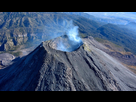I'm struggling with a volcano crater volume calculation project.
--AIM--
Be able to define the volume differentiation between two models of the crater (The volcano crater is changing due to the activity and we would like to know the difference between the volume of the crater of 2018 and 2019)
--AVAILABLE DATA--
We built a model with the software "AGISOFT". From this program we can export Mesh (.obj files), cloud (.las files),...


--IDEAS TO PROCESS THE DATA--
1) Volume comparison Mesh to Mesh
Directly calculate the difference inside the crater between two meshs
2) Volume comparison Mesh to cloud
calculate the difference inside the crater between a mesh and a cloud (lose of accuracy ?)
3) Volume comparison cloud to cloud
calculate the difference inside the crater between a mesh and a cloud (lose of accuracy twice more ?)
4) Create a plan surface which will cover the crater(accurately)
Calculate the volume of one crater, and then repeat the process with the other. The surface must to fit the crater (manually done maybe ?)
--ISSUES-- (otherwise it couldn't be funny)
- Maybe this is the main issue, the crater is an open model ( the cater isn't cover by something), so can we focus the volume calculation on the space inside the crater ? If we can't, the idea 4) is possible ?
- The current crater couldn't be properly modelizied, because we had to delete the part from which volcanic gases come. In result we have a hole in the model, but there is a tool to close the holes in cloudcompare. Can we close the hole on a mesh/cloud ?

- Usually we have been worked with an another program (currently it dosen't work), and this program calculate the volume variation from a mesh (.obj file). If we work with a cloud (.las file) (if we need to, for this kind of process) do we lose accuracy ? If yes, how much (estimation) ?
--Others--
I'm aware of the georeferencing process, and the align process,... before the volume calculation
And there is a cool photo of the Colima voclano :D

Thank you in advance !




